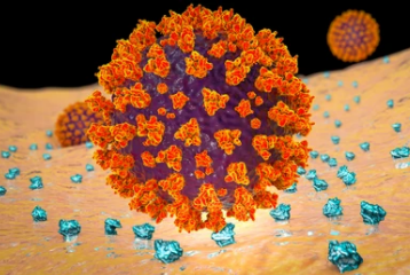Development of Glycoproteomics Analysis Techniques
 Glycosylation of proteins is an extremely important post-translational modification. About 80% of proteins in cells have glycosylation, which is mainly regulated by glycosyltransferases and glycosidases located in the endoplasmic reticulum and golgi apparatus. With the development of glycoprotein analysis and identification techniques, studies on the identification and analysis of the structure of glycoprotein and glycan are making continuous progress. To date, there are many commonly used techniques for glycoprotein analysis, such as mass-spectrometric technology, glycan array technology, and glycan-recognizing probes. These techniques are not only helpful to reveal the glycosylation process of proteins, but also valuable to study the mechanism of viral infection and antiviral process of the host.
Glycosylation of proteins is an extremely important post-translational modification. About 80% of proteins in cells have glycosylation, which is mainly regulated by glycosyltransferases and glycosidases located in the endoplasmic reticulum and golgi apparatus. With the development of glycoprotein analysis and identification techniques, studies on the identification and analysis of the structure of glycoprotein and glycan are making continuous progress. To date, there are many commonly used techniques for glycoprotein analysis, such as mass-spectrometric technology, glycan array technology, and glycan-recognizing probes. These techniques are not only helpful to reveal the glycosylation process of proteins, but also valuable to study the mechanism of viral infection and antiviral process of the host.
Mass spectrometry (MS)-based glycoprotein analysis
MS is a pivotal technique and has been widely used for the analysis of glycosylation on viral envelope glycoproteins. Based on MS, the structure of glycoprotein can be identified, the site-specific glycan can be characterized.
- Matrix-assisted laser desorption/ionization mass spectrometry (MALDI-MS)
As one of the most commonly used tools in glycan analysis, MALDI-MS combined with lectin microarray is able to provide a more reliable characterization of the glycan structure.
- Capillary electrophoresis-mass spectrometry (CE-MS)
CE-MS is a useful tool in determining site-specific glycan micro-heterogeneity of glycoproteins at the glycopeptide level, as well as in peptide mapping and glycoform.
- Hydrophilic interaction chromatography coupled with mass spectrometry HILIC-MS
HILIC provides better separation of hydrophilic glycopeptides as well as regular peptides but not glycopeptide isomers. HILIC-MS are used to determine the characterization of protein glycosylation site(s) and occupancy.
- Electrospray ionization mass spectrometry (ESI-MS)
Electrospray ionization mass spectrometry (ESI-MS) and tandem (MSn) mass spectrometry fragmentation techniques can be used to further characterize the structure of the selected chitosan ions, allowing differentiation between “isobaric” glycans.
In addition, LC with a better separation system and trapped ion mobility spectrometry (TI-MS) have recently been applied to differentiate the isomers of permethylated glycans.
Glycan microarrays for decoding the glycome
Glycan microarrays have greatly promoted the analysis of the specificity of glycoproteins, decoding the information content of the glycome as well as providing information that illuminates the biology mediated by them. Glycan microarrays systematically array glycan libraries and identify the specificities of glycan binding proteins (GBPs) to enable investigations into their biological roles. The development of glycan microarrays met a critical need for high-throughput methods at the turn of the 21st century. Since their introduction, the study of glycan microarrays and their biological applications has been significantly developed. In addition, their development has paralleled the complementary technologies used for the interrogation of glycan structure and function, such as lectin microarrays, chemical glycobiology, and analytical glycomics.
Glycan-recognizing probes as tools
Glycan-recognizing probes (GRPs), which include lectins, viral agglutinins, microbial adhesins, antibodies, and other proteins with carbohydrate-binding modules, have been widely applied in glycan analysis due to their specificities allowing the discrimination of a diverse variety of glycan structures. The native multivalency of some of the molecules improves high-affinity avidity binding to the glycans as well as cell surfaces containing those glycans.
Creative Proteomics is an international contract research organization (CRO) providing a series of viral glycoproteomics services. We are dedicated to providing a range of services tailored to meet our customers' needs. Feel free to contact us with your inquiries about viral glycoproteomics.
Related services
* For research use only.

 Glycosylation of proteins is an extremely important post-translational modification. About 80% of proteins in cells have glycosylation, which is mainly regulated by glycosyltransferases and glycosidases located in the endoplasmic reticulum and golgi apparatus. With the development of glycoprotein analysis and identification techniques, studies on the identification and analysis of the structure of glycoprotein and glycan are making continuous progress. To date, there are many commonly used techniques for glycoprotein analysis, such as mass-spectrometric technology, glycan array technology, and glycan-recognizing probes. These techniques are not only helpful to reveal the glycosylation process of proteins, but also valuable to study the mechanism of viral infection and antiviral process of the host.
Glycosylation of proteins is an extremely important post-translational modification. About 80% of proteins in cells have glycosylation, which is mainly regulated by glycosyltransferases and glycosidases located in the endoplasmic reticulum and golgi apparatus. With the development of glycoprotein analysis and identification techniques, studies on the identification and analysis of the structure of glycoprotein and glycan are making continuous progress. To date, there are many commonly used techniques for glycoprotein analysis, such as mass-spectrometric technology, glycan array technology, and glycan-recognizing probes. These techniques are not only helpful to reveal the glycosylation process of proteins, but also valuable to study the mechanism of viral infection and antiviral process of the host.